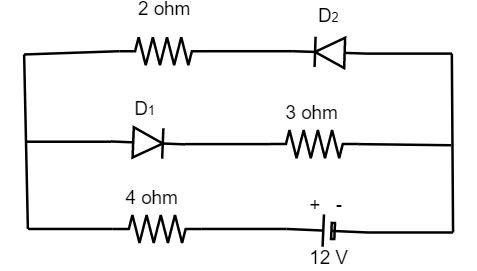
The circuit has two oppositely connected ideal diodes in parallel. What is the current flowing in the circuit?

A) $1.71\,A$
B) $2.0\,A$
C) $2.31\,A$
D) $1.33\,A$
Answer
218.4k+ views
Hint: The diode is forward biased if the positive terminal is connected to $P$ side and the negative terminal is connected to $N$ side of the diode. The condition is opposite for the reverse biased. Calculate the equivalent resistance from the circuit and apply in the ohm’s law to find the value of the current.
Formula used:
The ohm’s law is given by
$V = IR$
Where $V$ is the voltage developed across the circuit, $I$ is the current flowing through the circuit and $R$ is the equivalent resistance of the circuit.
Complete step by step solution:
From the given circuit diagram, it is clear that the diode ${D_1}$ is forward biased and the diode ${D_2}$ is reverse biased in nature. Hence ${D_2}$ has no current flows through it where ${D_1}$ has some amount of current flowing through it due to the changes in the value of the resistance for both. Since no current flows through the diode ${D_2}$, its resistance is not considered for calculating the equivalent resistance of the circuit.
${R_{eq}} = 3 + 4 = 7\,\Omega $
The value of the equivalent resistance is obtained as $7\,\Omega $ .
Using the formula of the ohm’s law,
$V = IR$
Rearranging the above formula, we get
$I = \dfrac{V}{R}$
Substituting the known values in it,
$\Rightarrow I = \dfrac{{12}}{7} = 1.71\,A$
Hence the current of the circuit is calculated as $1.71\,A$ .
Thus the option (A) is correct.
Note: Remember that if the diode in the circuit is reversely biased, then it will have the infinite resistance and so no current flows through it. If the diode is forward biased, the resistance of this diode will be zero and hence maximum current flows through it.
Formula used:
The ohm’s law is given by
$V = IR$
Where $V$ is the voltage developed across the circuit, $I$ is the current flowing through the circuit and $R$ is the equivalent resistance of the circuit.
Complete step by step solution:
From the given circuit diagram, it is clear that the diode ${D_1}$ is forward biased and the diode ${D_2}$ is reverse biased in nature. Hence ${D_2}$ has no current flows through it where ${D_1}$ has some amount of current flowing through it due to the changes in the value of the resistance for both. Since no current flows through the diode ${D_2}$, its resistance is not considered for calculating the equivalent resistance of the circuit.
${R_{eq}} = 3 + 4 = 7\,\Omega $
The value of the equivalent resistance is obtained as $7\,\Omega $ .
Using the formula of the ohm’s law,
$V = IR$
Rearranging the above formula, we get
$I = \dfrac{V}{R}$
Substituting the known values in it,
$\Rightarrow I = \dfrac{{12}}{7} = 1.71\,A$
Hence the current of the circuit is calculated as $1.71\,A$ .
Thus the option (A) is correct.
Note: Remember that if the diode in the circuit is reversely biased, then it will have the infinite resistance and so no current flows through it. If the diode is forward biased, the resistance of this diode will be zero and hence maximum current flows through it.
Recently Updated Pages
A square frame of side 10 cm and a long straight wire class 12 physics JEE_Main

The work done in slowly moving an electron of charge class 12 physics JEE_Main

Two identical charged spheres suspended from a common class 12 physics JEE_Main

According to Bohrs theory the timeaveraged magnetic class 12 physics JEE_Main

ill in the blanks Pure tungsten has A Low resistivity class 12 physics JEE_Main

The value of the resistor RS needed in the DC voltage class 12 physics JEE_Main

Trending doubts
JEE Main 2026: Application Form Open, Exam Dates, Syllabus, Eligibility & Question Papers

Derivation of Equation of Trajectory Explained for Students

Hybridisation in Chemistry – Concept, Types & Applications

Understanding the Angle of Deviation in a Prism

Understanding Collisions: Types and Examples for Students

Understanding Atomic Structure for Beginners

Other Pages
JEE Advanced Marks vs Ranks 2025: Understanding Category-wise Qualifying Marks and Previous Year Cut-offs

How to Convert a Galvanometer into an Ammeter or Voltmeter

Understanding Centrifugal Force in Physics

JEE Main Marking Scheme 2026- Paper-Wise Marks Distribution and Negative Marking Details

Degree of Dissociation: Meaning, Formula, Calculation & Uses

Understanding Electromagnetic Waves and Their Importance




